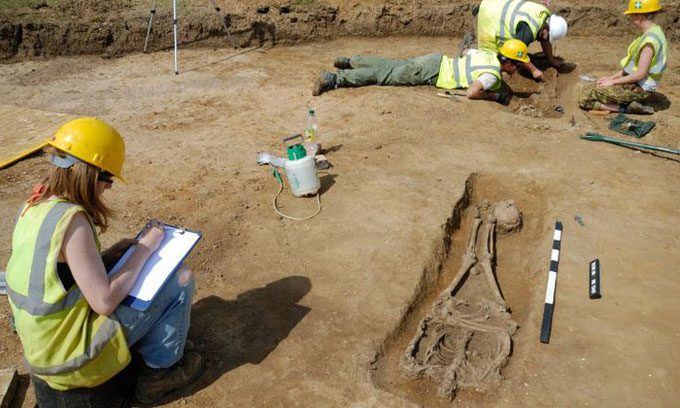Unstable governance and strict laws may be the reasons for the unusually high number of executions at the ancient cemetery in Knobb’s Farm.
The Cambridge Archaeological Unit (CAU) discovered 52 graves while excavating the Knobb’s Farm area in Somersham, Cambridgeshire, CNN reported on May 31. These graves date back to Roman times, with as many as 17 skulls having been decapitated and 13 skeletons buried face down—a notably high ratio. The Roman Empire dominated areas of England for about 400 years, from 43 to 410 AD.

Skulls of several skeletons in the Roman cemetery placed at their feet. (Photo: Dave Webb/CAU).
Many of the skulls were found at the feet of the skeletons, and some of the deceased were in a kneeling position, according to a study published in the journal Britannia. Many skeletons were in poor condition but showed no signs of defensive injuries or direct trauma before death, except for decapitation. This suggests that these deaths were premeditated.
The number of decapitated individuals and those buried face down is particularly high compared to other Roman cemeteries in England. 33% of the skeletons were decapitated, while the normal range is only about 2.5-6.1%.
Experts are unclear why some individuals were buried face down, but this is certainly not a mistake, as there are 13 such skeletons. The reason could be that these individuals were criminals or that their families were ashamed of them.
“DNA shows that there are 9 groups of people from various places. These settlements are vast rural areas that provided grain and meat for the Roman army,” said Isabel Lisboa, director of the archaeological consulting firm Archaeologica.
Lisboa believes it is highly likely that the 17 decapitated individuals were punished for crimes or according to some ritual. During the later stages of Roman rule in England, the number of crimes punishable by death increased from 14 to 60 due to the increasingly unstable governance. “It appears that Roman law was applied very strictly at Knobb’s Farm due to its connection with supplying goods to the Roman army,” Lisboa stated.
Most of the skeletons belonged to individuals over 25 years old, some showing signs of anemia and dental issues. There were 15 graves containing jars and small pottery, such as cups dating back to the 3rd and 4th centuries. The archaeological team also found a comb in the grave of a woman, which may have been in her hair at the time of her execution.




















































